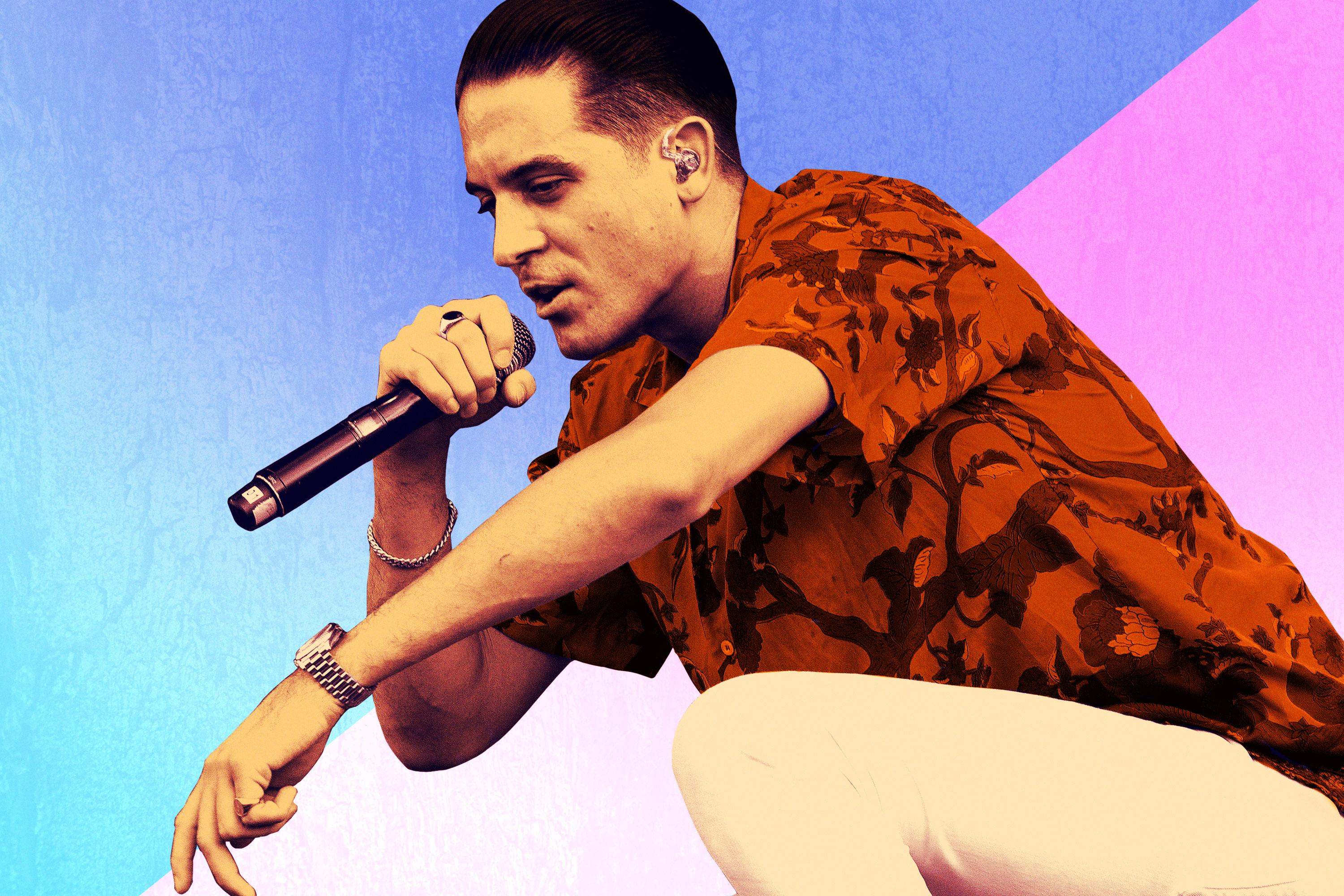
Think of G-Eazy, the Oakland rapper and improbably flourishing pop star, as the sort of melodramatic bad boy Lana Del Rey is always writing songs about. The doomed matinee idol, the dolorous hedonist, the wayward dreamboat. He is nearly 6 1/2 feet tall, with slicked-back jet-black hair to better accentuate his black leather jacket. On the striking cover of his third major-label album, The Beautiful & Damned, his pretty face is going to hell, battered and bruised, with bloodstains all along the collar of his white T-shirt. He is Evil Agent Cooper; he is darkest-timeline Macklemore. I am only slightly trolling when I suggest that Eminem’s Revival might not even be the biggest album by a white rapper coming out this week.
Born Gerald Earl Gillum, G-Eazy specializes in Top 40 duets with maximally ethereal female vocalists, from the 2016 Britney Spears comeback bid “Make Me…” to his double bill with Kehlani on the Fate of the Furious soundtrack jam “Good Life.” Most prominently, there is 2015’s Bebe Rexha teamup “Me, Myself & I,” a moody ode to solitude and solipsism that cracked the Top 10 and might even rank among the top-five songs with that title. In an alarmingly homogenized pop-radio landscape — where each and every new hit is a soothing puree of trap, EDM, noirish R&B, and capitalist indie quirk — his workmanlike voice, neither too clunky nor too distinct, fits in without standing out.
He is a better rapper now than he was in 2014, when his breakout album, These Things Happen, yielded cringy hits like “I Mean It” and “Tumblr Girls,” which has a disconcertingly lovely beat marred by such fake-deep lyrical boners as “She said she can’t feel her face / Right now I can’t feel my heart.” G-Eazy has little to talk about other than his bad-boy status, the bad-girl status of his various paramours, and the improbably flourishing pop stardom his fealty to these topics has brought him. The Beautiful & Damned has landed two prerelease singles in the upper reaches of the Hot 100, including “Him & I,” a sultry duet with his girlfriend, Halsey, which they performed this week on Jimmy Kimmel Live!. (Please note the resplendent Inspector Gadget coat.) If you ever find yourself in a hotel room next door to these two, I recommend you switch to a different hotel across town.
It is best not to take this person too seriously, and vital that he continues not to take himself very seriously at all. Here is G-Eazy explaining to Genius the thinking behind the dead-eyed hook “Fuck with me and get some money,” which animates his other current hit, “No Limit”:
“No Limit” is the best song on The Beautiful & Damned, if only for the more animating presence of both A$AP Rocky (whose hook harkens back to his far superior 2013 hit “Fuckin’ Problems”) and Cardi B (“Can you stop with all the subs? / Bitch, I ain’t Jared”). But per the cover image, most of this album is far darker and grimmer, exploring the ways all that money and fame has warped and isolated Young Gerald. Think of it as a bargain-basement version of Drake’s Views with way less toxic resentment but also way less, y’know, craft. “Pray for Me” has a similarly dead-eyed ad nauseum hook of “Pray for me / Pray for me / Pray for me / Pray for me”; “Sober,” with its yelping Charlie Puth hook and shout-outs to Kobe Bryant and Jim Morrison, celebrates G-Eazy’s sex life as a byproduct of his problem drinking. (“Try, but it all falls down like Tetris / No telling where that 80-proof gets us.”) What a time to be dead inside.
There are other things to talk about, but he’d rather not talk about them, and I’m not convinced you want him to talk about them either. One thing G-Eazy doesn’t rap about much, at least these days, is his race, which is some combination of an inevitability, a relief, and a red flag. “But the joke is this,” writes poet and critic Hanif Abdurraqib in “The White Rapper Joke,” a highlight of his fantastic new essay collection, They Can’t Kill Us Until They Kill Us. “Every white rapper is the whole of the white rappers that came before them, because when there are so few of you, it becomes easy to avoid falling into the same patterns.” Abdurraqib traces the lineage from Vanilla Ice to Eminem to rock-star-esque Cleveland phenom Machine Gun Kelly (probably G-Eazy’s closest stylistic analogue) to uber-preppy also-ran Asher Roth to Macklemore, who in a few short years as a pop supernova turned white privilege (and white guilt) from his subtext to his very explicit text.
G-Eazy’s innovation — the way he avoids falling into those same patterns — lies in his disinclination to grapple with these issues much at all anymore, at least on record. Early in his career, naturally, he discussed the white-rapper topic in interviews at some length, and with some exasperation. “I’ve been doing this for 10 years, and it comes from a genuine place,” he told The Guardian in 2014. “I didn’t grow up around all white people, I never wanted to gentrify hip-hop, I’ve never wanted to speak to an all-white audience. I’m just making music and I’m paying my bills.”
This color-blind approach still causes friction — last year The New York Times’ Jon Caramanica cited G-Eazy as emblematic of a new fleet of white rappers finding fame through “a hip-hop side door,” with little support from black audiences, black gatekeepers, or black mentors (à la Eminem and Dr. Dre). It’s not that G-Eazy is apolitical, exactly: Last year, he showed up alongside Macklemore on the sequel to YG’s industry-standard anti–President Donald Trump anthem, “FDT,” and he sneaks a lengthy and pointed follow-up onto a late The Beautiful & Damned track called “Love Is Gone”:
As I sit in the studio, I guess the thinking is
If this statement is too crazy, then should I finish this
Or if my image is pretty, don’t want to blemish this
Or ever split up my fans, reduce my relevance
Pay attention and understand what the premise is
Everything not gravy, we can’t pretend it is
So I salute YG, fuck the president
’Cause he a fuckin’ racist supported by white supremacists
This outburst is all the more startling for how anomalous it is on a 20-track record far more weighted toward empty-calorie odes to the poisonous lifestyles of the increasingly rich and famous. Which in turn makes it fascinating counterprogramming with Eminem’s Revival, whose early singles and promo opportunities suggest something way more discordant and consistently confrontational.
By contrast, The Beautiful & Damned is the sort of good-enough pop-rap record where the bad parts are more interesting than the good parts. All those moaned hooks and triumphant-downer raps fuse together to the point of feeling interchangeable, like modular furniture in a hotel penthouse that’s gonna be totally trashed in the next 30 seconds. G-Eazy can capably ape Drake (on the swaggering, triumphant “The Plan”) or less capably ape Future (he mumbles amid jaunty flutes on “Gotdamn”). But he’s most engrossing at his sleepiest and most experimental, which is another way of saying that I might like this record better if it were worse.
You might find yourself skipping around, desperate for idiosyncrasy. The downtempo “Summer in December” weaves dusty drums, meandering jazz piano, and turntable squiggles in a way that’s perhaps meant to nod vaguely toward DJ Shadow’s Entroducing. “Charles Brown” keeps the piano, adds a couple of Bay Area rappers (E-40 and Jay Ant), and attempts something like “chillout hyphy.” The results are no outsize success, but they feel distinct from the rootless Spotify-algorithm approach the rest of The Beautiful & Damned takes, aiming for RapCaviar and settling for Today’s Top Hits. The text here is that chart success has corrupted Young Gerald. The subtext is that it’s made him so numbly formulaic that nobody else can feel his heart at all.

